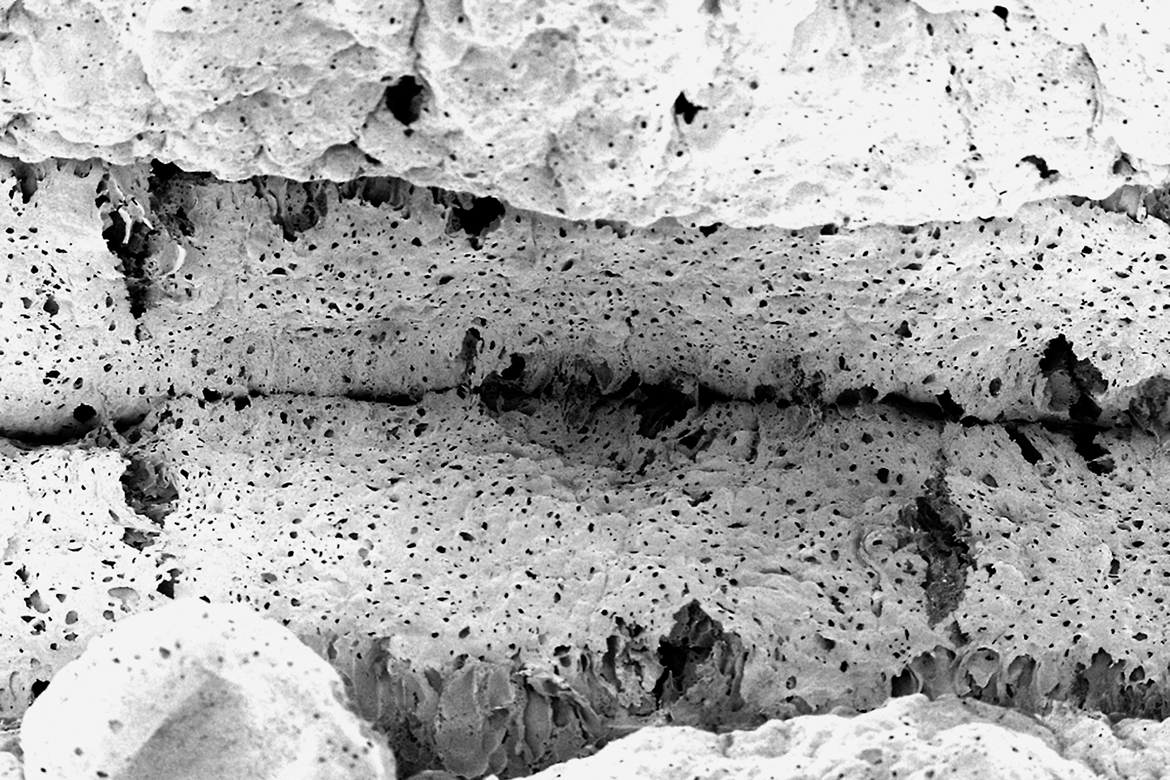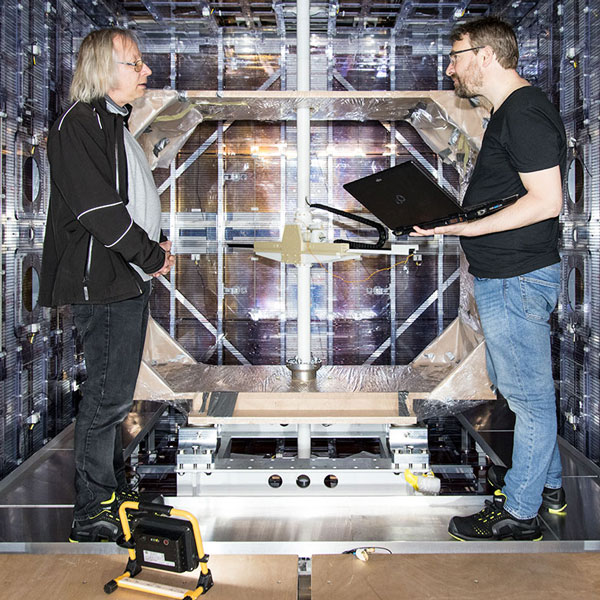Pinning down demise
The precise moment of death cannot be determined unambiguously. But society needs a clear criterion for decease – not least because of issues such as organ donation.

77-year-old patient with lung cancer, 11 days before his death
Regardless of whether we die early by accident, or whether we reach a biblical age before our demise: at some point, our heart will stop for good. At some point, we shall also stop breathing. And at some point, our brain will also cease to function.
“It can take up to a week until the final cell in the body has died off”, explains Stephan Marsch, Head of the Intensive Care Unit at the University Hospital of Basel. But when asked for the precise moment when the transition from life to death occurs, not even he can give a definitive answer. “In biological terms, death is a process”. For example, the cornea can still be transplanted successfully three days after death. And up to a week after death it is still possible to remove and cultivate specific types of cell from the body, such as cartilage.
Irreversibility is key
But there are legal and societal demands to establish a more precise boundary. “We can’t say that someone is a little bit dead, or that they’re still a little bit alive”, says Marsch. But the binary ‘yes or no’ cannot be so easily reconciled with a biological process. That is why experts make use of the criterion of empirical irreversibility. “If, in line with accumulated experience, a person cannot come back to life, or cannot be reanimated, then he or she is regarded as dead”.
Opinions about when this point is reached have changed several times over the course of medical history. Until the 19th century, people depended on their own observations. In cases of doubt they waited several hours until rigor mortis had set in. Only after the invention of the stethoscope did the medical profession recognise the connection between the beating heart and life itself. Though they weren’t quite certain about that, either. Medical historians tell of sometimes brutal methods with which a doctor might determine that their patient was truly dead – such as sticking needles under their toenails, or dripping hot wax onto their forehead. But better stethoscopes soon enabled them to realise that cardiac arrest was a reliable way of knowing that someone had indeed died.
From cardiac arrest to brain death
With the rapid development of intensive medicine in the 1960s, however, began the questioning of the validity of cardiac death. The advent of artificial respiration meant people could now be kept alive, when the failure of spontaneous breathing would otherwise have led swiftly to cardiac arrest. But in some of these patients, the brain had completely ceased to function. So were they now alive or dead? At about the same time, transplant medicine was celebrating its initial successes – and it was precisely these people on artificial respiration who were particularly suited to organ donation, because their heart, kidneys and lungs were still fully functioning. So pressure grew to find a new, reliable criterion for death in such cases. In 1968, a committee at Harvard Medical School first suggested using brain death.
Brain death is defined in Switzerland as the irreversible failure of brain function, including that of the brain stem. The brain stem is regarded as the most resilient part of the brain and is the seat of the respiratory centre. If the brain stem stops working, then breathing stops, and the heart gets no more oxygen. Without artificial respiration, cardiac arrest is inevitable. Conversely, cardiac arrest also brings about brain death in the shortest space of time. Because if the brain is not provided with oxygen through the circulation of the blood, then brain activity ceases after about ten minutes.
The same death for all
In Switzerland, it was the implementation of the Transplantation Act in 2007 that first brought about the recognition of brain death as the unique criterion for death in all cases. The bill for the law referred to the guidelines of the Swiss Academy of Medical Sciences (SAMS). They, in turn, stipulate what clinical signs of brain death must be determined, and how to do so. These include the lack of specific reflexes, dilated pupils, and a respiratory stop after artificial respiration has been removed.
Jürg Steiger, the head of the Department of Transplantation Immunology and Nephrology at the University Hospital of Basel, regards the current definition and diagnosis of brain death as safe and reliable. As the chairman of the Central Ethics Committee of the SAMS and of its subcommittee for revising the guidelines, he has been involved with this topic for many years now. “The criteria have remained unchanged for twenty or thirty years. There is no evidence at all that we should change anything”. Nevertheless, he can well understand that the concept of brain death is difficult to grasp for many people. A brain-dead person on artificial respiration looks like he is still breathing. And his body is warm.
Residual brain activity
However, doubts regarding the validity of brain death arise not just on account of external perceptions. Brain-dead people can also maintain many metabolic processes independently. They digest, regulate their hormonal balance, and fight infections. In some cases, brain-dead women have even given birth to healthy babies. Critics of the brain death approach also point out that, after brain stem activity ceases, residual activity can still be proven to occur in individual cells of the cerebral cortex. It is also disputed whether an organ donor might still be able to feel pain. The SAMS guidelines stipulate that anaesthesia is to be administered during the removal of organs, but this is a quite unrelated matter; the anaesthetic is intended to suppress reflexes that can still be transmitted through the intact spinal cord.
For Steiger, the brain remains the decisive organ – also as a result of his personal experiences with dying people and with the deceased. “The heart is just a pump that you can replace with a mechanical device if necessary. For me, life occurs in our head: pain, love and hate”. Even someone who has had a leg amputated can still feel pain in a toe. This is a clear sign that the pain is perceived in the brain, not in the rest of the body. “If the brain doesn’t function any longer, a central aspect of your personality also disappears”.
Personalised criteria for death?
Just where our personality actually resides, and whether it is extinguished at the point of brain death, was barely discussed in Switzerland when the law was introduced in 2007. Ethical discussions were focussed chiefly on aspects of consent for organ removal and the equitable distribution of the organs donated. Pascal Lachenmeier is a legal scholar whose doctoral thesis at the University of Basel undertook a closer analysis of determining the point of death as enshrined in the Transplantation Act. “Introducing the concept of brain death did not cause many waves in the general population. People don’t like to address the matter of their own death, and in this case they relied on the natural sciences to provide a safe method”. He regrets that the legislators treated the criterion of death as a purely technical matter, delegating it to an institution such as the SAMS instead of holding a broader social debate about death.
The fact that the criterion of brain death has meanwhile become valid in almost all countries does not mean that it is incontrovertible. In the USA, for example, some have suggested using the loss of cognitive abilities as sufficient proof of death – in other words, the moment when the cerebrum ceases to function. Lachenmeier, however, suggests a fundamentally different concept, and questions whether a society can, or must, have any generally valid definition of death. In order to take into account all the different understandings of the point of death, all people should instead be allowed to define individually what for them constitutes the boundary between life and death – inasmuch as irreversibility is guaranteed, as in the case of brain death or cardiac arrest.
Yvonne Vahlensieck is a freelance science journalist who lives near Basel.
“But if death took place further back, we can only offer rough estimates as to how many weeks, months or years”, explains Silke Grabherr, the director of the University Center of Legal Medicine, Lausanne – Geneva. The most important indicator is the process of decomposition, which spreads from the intestinal flora through the blood vessels in the body. A further indication is gained from the condition of a wax-like substance that forms from body fat in so-called ‘wax corpses’ in the absence of air.
But Grabherr believes that analysing flies and maggots that settle in a corpse is usually unreliable: “You rarely know for sure whether these are really the first generation of the insects”. Other methods might be able to determine the time of death using the concentration of metabolic products in bodily fluids. But these are still in their development phase.




